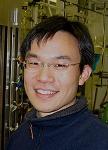Org. Synth. 2009, 86, 130
DOI: 10.15227/orgsyn.086.0130
PROTECTION OF DIOLS WITH 4-(tert-BUTYLDIMETHYLSILYLOXY)BENZYLIDENE ACETAL AND ITS DEPROTECTION:
[(4-((4R,5R)-4,5-DIPHENYL-1,3-DIOXOLAN-2-YL)PHENOXY)(tert- BUTYL)DIMETHYLSILANE]
Submitted by Hiroyuki Osajima
1, Hideto Fujiwara
2, Kentaro Okano
2, Hidetoshi Tokuyama
2, and Tohru Fukuyama
1.
Checked by Scott E. Denmark and Wen-Tau T. Chang.
1. Procedure
A. (4-(Dimethoxymethyl)phenoxy)(tert-butyl)dimethylsilane. A 100-mL oven-dried, three-necked round-bottomed flask equipped with a Teflon-coated magnetic stir bar, a rubber septum, a thermocouple and an argon gas inlet is charged with tert-butylchlorodimethylsilane (6.08 g, 40.3 mmol) (Note 1) and DMF (20 mL) (Note 2). To the mixture are added 4-hydroxybenzaldehyde (4.92 g, 40.3 mmol) (Note 3), imidazole (4.12 g, 60.5 mmol) (Note 4), and 4-dimethylaminopyridine (0.248 g, 2.02 mmol) (Note 5) in separate portions with stirring. After being stirred for 2 h (Note 6) at ambient temperature (19 °C), the reaction mixture is poured into water (30 mL) in a 500-mL separatory funnel and the suspension is extracted with EtOAc (2 × 25 mL). The combined organic extracts are diluted with EtOAc (50 mL), and then washed with 5% aq. NaCl solution (100 mL), water (4 × 100 mL), and sat. aq. NaCl solution (100 mL), then are dried over anhydrous MgSO4 (1.6 g), filtered, and concentrated on a rotary evaporator (20 °C, 30 mmHg). The residue is dissolved with toluene (50 mL) and the resulting solution is concentrated on a rotary evaporator (40 °C, 30 mmHg) (Note 7) to give a pale yellow oil (9.43 g) (Note 8). The crude product is used in the next step without further purification (Note 9).
A 500-mL, oven-dried, three-necked round-bottomed flask equipped with a Teflon-coated magnetic stir bar, a rubber septum, a thermocouple and an argon gas inlet is charged with the crude product prepared above (9.43 g), MeOH (60 mL) (Note 10), and trimethyl orthoformate (40 mL) (Note 11). To the mixture is added pyridinium p-toluenesulfonate (1.01 g, 4.03 mmol) (Note 12). After being heated in a 50 °C oil bath (internal temperature: 43 °C) for 3.5 h (Note 13), the solution is cooled to ambient temperature and is poured into sat. aq. NaHCO3 solution (100 mL) in a 1-L separatory funnel. The two-phase mixture is extracted with EtOAc (3 × 100 mL) and the combined organic extracts are washed with sat. aq. NaCl solution (2 × 100 mL), then are dried over Na2SO4 (2.2 g), filtered, and concentrated on a rotary evaporator (20 °C, 30 mmHg). The residue is dissolved with toluene (50 mL) and the resulting solution is concentrated on a rotary evaporator (40 °C, 30 mmHg) (Note 7) to give a yellow oil (10.07 g). The oil is purified by silica gel column chromatography (elution with hexanes/EtOAc, 20:1) (Notes 14, 15) to yield (4-(dimethoxymethyl)phenoxy)(tert-butyl)dimethyl silane (9.66 g, 85%) (Note 16).
B. (4- ((4R, 5R)-4,5- Diphenyl-1,3- dioxolan-2-yl) phenoxy) (tert- butyl)dimethylsilane. A 500-mL, oven-dried, three-necked round-bottomed flask equipped with a reflux condenser (fitted with an argon gas inlet), a Teflon-coated magnetic stir bar, a rubber septum, and a thermocouple is charged with (1R,2R)-1,2-diphenylethane-1,2-diol (6.43 g, 30.0 mmol) (Note 17), toluene (96.0 mL) (Note 18), MeCN (32.0 mL) (Note 19), and (4-(dimethoxymethyl)phenoxy)(tert-butyl)dimethylsilane (9.27 g, 32.8 mmol). After stirring the solution for 3 min, pyridinium p-toluenesulfonate (2.26 g, 9.0 mmol) (Note 11) is added. The reaction mixture is heated in a 50 °C oil bath (internal temperature: 45 °C) and is stirred for 1 h (Note 20). The mixture is cooled to ambient temperature and then is poured into sat. aq. NaHCO3 solution (100 mL) in a 1-L separatory funnel, and the suspension is extracted with EtOAc (3 × 100 mL). The combined organic extracts are washed with sat. aq. NaCl solution (2 × 100 mL), then are dried over anhydrous Na2SO4 (20 g), filtered, and concentrated on a rotary evaporator under reduced pressure to give a yellow, viscous oil. The residue is purified by silica gel column chromatography (elution with hexanes/CH2Cl2, 7:3) (Notes 21, 22) to give a colorless, viscous oil (12.33 g) (Note 23) which is triturated with MeOH to yield (4-((4R,5R)-4,5-diphenyl-1,3- dioxolan-2-yl)phenoxy) (tert-butyl) dimethylsilane as a white solid (11.51 g, 89%) (Note 24).
C. (1R,2R)-1,2-Diphenylethane-1,2-diol. A 500-mL, three-necked round-bottomed flask equipped with a reflux condenser (fitted with an argon inlet), a Teflon-coated magnetic stir bar, a rubber septum, and a thermocouple is charged with (4-((4R,5R)-4,5-diphenyl-1,3- dioxolan-2-yl) phenoxy) (tert-butyl)dimethylsilane (10.8 g, 25.0 mmol), K2CO3 (17.3 g, 125 mmol) (Note 25), MeOH (200 mL) (Note 9), and water (50 mL). After addition of KF (1.46 g, 25.0 mmol) (Note 26) and stirring for 5 min followed by addition of NH2OH·HCl (8.69 g, 125 mmol) (Note 27), the reaction mixture is heated in an 85 °C oil bath (internal temperature: 69 °C) and is stirred for 37 h (Note 28). The reaction mixture is cooled to ambient temperature and is decanted (Note 29) into sat. brine (150 mL) in a 1-L separatory funnel and is extracted with EtOAc (3 × 200 mL). The combined organic extracts are washed with 3 M NaOH (3 × 100 mL), H2O (100 mL), and brine (100 mL), and then are dried over anhydrous Na2SO4 (20 g), filtered, and concentrated on a rotary evaporator (21 °C 30 mmHg) to afford 5.40 g of the crude diol as a white solid. Purification by recrystallization yields (1R,2R)-1,2- diphenylethane-1,2-diol as white crystals (4.65 g, 87%) (Notes 30, 31).
2. Notes
1.
tert-Butylchlorodimethylsilane (97%) was purchased from Aldrich Chemical Company, Inc. and used as received without further purification.
2.
DMF (99.9%, water content: < 0.02%) was purchased from Fisher Scientific and used as received without further purification.
3.
4-Hydroxybenzaldehyde (98%) was purchased from Aldrich Chemical Company, Inc. and used as received without further purification.
4.
Imidazole (99%) was purchased from Aldrich Chemical Company, Inc. and used as received without further purification.
5.
4-Dimethylaminopyridine (99%) was purchased from Aldrich Chemical Company, Inc. and used as received without further purification.
6.
The reaction typically requires 2 h to go to completion and is monitored by
1H NMR spectroscopy. A small aliquot of the reaction mixture is removed and is treated with brine. The organic layer is separated and concentrated under reduced pressure (30 °C, 30 mmHg) to afford the NMR sample. Stirring is stopped when the ratio of the signal for the formyl proton of the alcohol (δ 9.85, 1 H) to that of the TBS ether (δ 9.89, 1 H) is less than 0.10.
7.
Azeotropic removal of water was carried out with toluene (≥99.5%, water content: < 0.030%) purchased from Aldrich Chemical Company, Inc. and used as received without further purification.
8.
The ratio of the alcohol (δ 9.85, 1 H) to the TBS ether (δ 9.89, 1 H) is 0.06.
9.
The compound exhibits the following physicochemical properties:
Rf = 0.61 (hexanes/EtOAc, 4:1; Merck silica gel 60F-254 plate (visualized with 254 nm UV lamp and stained with an ethanol solution of Ce
2(SO
4)
3 and phosphomolybdic acid (Ce-PMA)); IR (neat) cm
-1: 2956, 2930, 2859, 1701, 1599, 1576, 1508, 1274, 1211, 1156, 909, 841, 800, 783, 705;
1H NMR
pdf (500 MHz, CDCl
3) δ: 0.25 (s, 6 H), 0.99 (s, 9 H), 6.94 (d,
J = 8.5 Hz, 2 H), 7.79 (d,
J = 8.5 Hz, 2 H), 9.89 (s, 1 H);
13C NMR
pdf (126 MHz, CDCl
3 δ: -4.4, 18.2, 25.5, 120.4, 130.4, 131.9, 161.5, 190.9.
10.
Methanol (≥99.8%, water content: < 0.100%) was purchased from Aldrich Chemical Company, Inc. and used as received without further purification.
11.
Trimethyl orthoformate (99%) was purchased from Aldrich Chemical Company, Inc. and used as received without further purification.
12.
Pyridinium p-toluenesulfonate (98%) was purchased from Aldrich Chemical Company, Inc. and used as received without further purification.
13.
The reaction typically requires 3.5 h to go to completion and is monitored by
1H NMR spectroscopy. A small aliquot of the reaction mixture is removed and treated with brine. The organic layer is concentrated under reduced pressure (30 °C, 30 mmHg) to afford the NMR sample. Heating and stirring is stopped when the ratio of the signal of the aldehyde (δ 9.89, 1 H) to that of the dimethyl acetal (δ 5.33, 1 H) is less than 0.05 for maximizing the yield and reproducibility.
14.
Silica gel (grade 9385, 60 Å) was purchased from Merck (230-400 mesh).
15.
The crude material is dissolved in eluent (5 mL) and then is charged onto a column (diameter = 5 cm, height = 5 cm) of 42 g of silica gel (slurry packed). The column was eluted with hexanes/EtOAc, 20:1 and 50-mL fractions were collected. Fraction 2-7 were combined and concentrated on a rotary evaporator under reduced pressure (30 °C, 30 mmHg).
16.
The compound exhibits the following physicochemical properties:
Rf = 0.71 (hexanes/EtOAc, 4:1; Merck silica gel 60F-254 plate (visualized with 254 nm UV lamp and stained with Ce-PMA)); IR (neat) cm
-1: 2955, 2931, 2896, 2858, 1610, 1511, 1472, 1362, 1264, 1165, 1099, 1056, 915, 840, 805, 781;
1H NMR
pdf (500 MHz, CDCl
3) δ: 0.19 (s, 6 H), 0.98 (s, 9 H), 3.31 (s, 6 H), 5.34 (s, 1 H), 6.83 (d,
J = 8.5 Hz, 2 H), 7.30 (d,
J = 8.5 Hz, 2 H);
13C NMR
pdf (126 MHz, CDCl
3) δ: -4.5, 18.2, 25.6, 52.6, 103.1, 119.8, 127.8, 130.9, 155.8; MS (EI)
m/z (relative intensity): 282.1 (9), 251.1 (100), 225.0 (24), 195 (6), 179 (6), 151 (4), 137 (3), 97 (4), 75 (39); Anal. Calcd for C
15H
26O
3Si: C, 63.78; H, 9.28. Found: C, 63.50; H, 9.64.
17.
(1
R,2
R)-1,2-Diphenylethane-1,2-diol (99%, 98% ee) was purchased from Aldrich Chemical Company, Inc. and used as received without further purification.
18.
Toluene (≥99.5%, water content: < 0.030%) was purchased from Aldrich Chemical Company, Inc. and used as received without further purification.
19.
MeCN (≥99.9%, water content: < 0.01%) was purchased from Fisher Scientific and used as received without further purification.
20.
The reaction typically requires 1 h to go to completion and is monitored by
1H NMR spectroscopy. A small aliquot of the reaction mixture is removed and treated with brine. The organic layer is separated and concentrated under reduced pressure (30 °C, 30 mmHg) to afford the NMR sample. Heating and stirring is stopped when the signal for the dimethyl acetal (δ 5.33, 1 H) is fully converted to the signal for the diphenylethane acetal (δ 6.36, 1 H).
21.
The crude material is dissolved in eluent (5 mL) and then is charged onto a column (diameter = 6 cm, height = 22 cm) of 345 g of silica gel (slurry packed). The column was eluted with hexanes/CH
2Cl
2, 7:3 and 50-mL fractions were collected. Fractions 17-53 were combined and concentrated on a rotary evaporator under reduced pressure (30 °C, 30 mmHg).
22.
Alternatively, the conversion to (4-((4
R,5
S)-4,5-diphenyl- 1,3-dioxolan-2-yl)phenoxy)(
tert-butyl)dimethylsilane could be carried out following the method of Noyori
3 using (4-(dimethoxymethyl)phenoxy)- (
tert-butyl)dimethylsilane and the bis(trimethylsilyl) ether.
23.
The checkers found that the product can be crystallized by addition of methanol (10 mL) followed by sonication for 15 min. The murky solution is cooled to -27 °C for 1 h to induce precipitation and the white solid is collected by filtration (10.79 g). A second crop (0.72 g) is obtained by sonicating the concentrated mother liquor in MeOH (5 mL) for 1 min and cooling to -27 °C for 1 h.
24.
The compound exhibits the following physicochemical properties:
Rf = 0.20 (hexanes/CH
2Cl
2, 7:3; Merck silica gel 60F-254 plate (visualized with 254 nm UV lamp and stained with Ce-PMA)); mp 46-47 °C (MeOH); IR (film) cm
-1: 2955, 2929, 2884, 2857, 1610, 1513, 1264, 1108, 1088, 1071, 1013, 913, 839, 803, 781, 762, 698;
1H NMR
pdf (500 MHz, CDCl
3) δ: 0.23 (s, 6 H), 1.01 (s, 9 H), 4.96 (s, 2 H), 6.36 (s, 1 H), 6.92 (d,
J = 8.5 Hz, 2 H), 7.30-7.39 (m, 10 H), 7.56 (d,
J = 8.5 Hz, 2 H);
13C NMR
pdf (126 MHz, CDCl
3) δ: -4.4, 18.2, 25.7, 85.2, 87.1, 104.8, 120.1, 126.3, 126.9, 128.09, 128.12, 128.50, 128.54, 128.57, 130.9, 136.6, 138.4, 156.7; MS (ESI)
m/z 433.3; MS (EI)
m/z (relative intensity): 326.2 (100), 297.2 (79), 269.1 (54), 241.1 (11), 220.1 (21), 179.1 (16), 149.0 (9), 91.1 (19), 73.1 (27); Anal. Calcd for C
27H
32O
3Si: C, 74.96; H, 7.46. Found: C, 74.69; H, 7.52.
25.
Potassium carbonate (98%, powdered, 325 mesh) was purchased from Aldrich Chemical Company, Inc. and used as received without further purification.
26.
Potassium fluoride (99%) was purchased from Alfa-Aesar and used as received without further purification.
27.
Hydroxylamine hydrochloride (98%) was purchased from Aldrich Chemical Company, Inc. and used as received without further purification.
28.
The reaction typically requires 26-37 h to go to completion and is monitored by
1H NMR spectroscopy. A small aliquot of the reaction mixture is removed and treated with brine. The organic layer is separated and concentrated under reduced pressure (30 °C, 30 mmHg) to afford the NMR sample. Heating and stirring is stopped when the ratio of the signal for the protected diol (δ 4.96, 2 H) to that for the starting diol (δ 4.70, 2 H) is less than 0.05 to maximize the yield and reproducibility.
29.
The salt generated in the reaction causes some emulsion during the extraction.
30.
To crystallize the product, the residue is dissolved in hot EtOAc/hexanes, 3:2 (100 mL). The solution is then cooled to room temperature and left in a freezer at -27 °C for 2 h. The colorless crystals are collected by filtration (4.01 g). A second crop of crystals (0.64 g) is obtained by dissolving the concentrated mother liquor in hot EtOAc/hexanes, 3:2 (13 mL) followed by the same cooling procedure.
31.
The compound exhibits the following physicochemical properties:
Rf = 0.52 (hexanes/EtOAc, 1:1; Merck silica gel 60F-254 plate (visualized with 254 nm UV lamp and stained with Ce-PMA)); mp 146-147 °C (hexane/EtOAc); IR (KBr) cm
-1: 3499, 3393, 2895, 1452, 1385, 1198, 1178, 1045, 1013, 846, 777, 747, 705, 695;
1H NMR
pdf (500 MHz, CDCl
3) δ: 2.92 (s, 2 H), 4.70 (s, 2 H), 7.10-7.14 (m, 4 H), 7.21-7.25 (m, 6 H);
13C NMR
pdf (126 MHz, CDCl
3) δ: 79.1, 126.9, 127.9, 128.1, 139.8; MS (EI)
m/
z (relative intensity): 214.1 (< 0.5%), 107.0 (100), 79.1 (81); Anal. Calcd for C
14H
14O
2: C, 78.48; H, 6.59. Found: C, 78.56; H, 6.66.
Handling and Disposal of Hazardous Chemicals
The procedures in this article are intended for use only by persons with prior training in experimental organic chemistry. All hazardous materials should be handled using the standard procedures for work with chemicals described in references such as "Prudent Practices in the Laboratory" (The National Academies Press, Washington, D.C., 2011 www.nap.edu). All chemical waste should be disposed of in accordance with local regulations. For general guidelines for the management of chemical waste, see Chapter 8 of Prudent Practices.
These procedures must be conducted at one's own risk. Organic Syntheses, Inc., its Editors, and its Board of Directors do not warrant or guarantee the safety of individuals using these procedures and hereby disclaim any liability for any injuries or damages claimed to have resulted from or related in any way to the procedures herein.
3. Discussion
Protection and deprotection of functional groups play a critical role in successful synthesis of multifunctionalized, complex molecules. Among a variety of protecting groups on 1,2-diols,
3 the most frequently used ones are cyclic acetals and ketals. However, since their deprotections generally require strongly acidic conditions, these protecting groups are generally incompatible with acid-labile functional groups. During the course of synthetic studies on leustroducsin B
4, we devised a novel benzylidene-type protecting group,
p-(
tert-butyldimethylsilyl-oxy)benzylidene group
5 (Scheme 1). This protecting group could be removed under a mild two-step sequence, desilylation of the phenolic hydroxyl group with (HF)
3·Et
3N and the subsequent treatment with weakly acidic conditions (AcOH-THF-H
2O). Exploitation of this protective group was the key to achieve the total synthesis of leusroducsin B bearing highly acid-sensitive functionalities.
Scheme 1. Mild Acidic Deprotection of a Novel Benzylidene-Type Protecting Group.
Further investigations on the utility of this newly developed protective group revealed that this group could also be removed in a single step under mild basic conditions (Scheme 2). Thus, treatment of the p-hydroxybenzylidene acetal with K2CO3 in MeOH-H2O at 70 °C gave the corresponding diol in almost quantitative yield. Furthermore, addition of NH2OH·HCl and CsF dramatically facilitated the deprotection process and the single-step deprotection of the TBS ether took place smoothly. Trapping of the liberated p-hydroxybenzaldehyde with hydroxylamine would accelerate the deprotection process under the equilibrium conditions.
Scheme 2. Single-Step Deprotection under Basic Conditions
As shown in Table 1, acid-labile functional groups such as the THP ether and triphenymethyl group were unaffected during the deprotection process. While benzyl ester could not tolerate these basic conditions, more robust pivaloyl ester survived.
Table 1. Chemoselective Deprotection of the Benzylidene-Group under Basic Conditionsa
Appendix
Chemical Abstracts Nomenclature (Collective Index Number);
(Registry Number)
tert-Butyldimethylsilyl chloride: Silane, chloro(1,1-dimethylethyl)dimethyl-; (18162-48-6)
4-Hydroxybenzaldehyde: Benzaldehyde, 4-hydroxy-; (123-08-0)
Imidazole: 1H-Imidazole; (288-32-4)
4-(Dimethylamino)pyridine: 4-Pyridinamine, N,N-dimethyl-; (1122-58-3)
Trimethyl orthoformate: Methane, trimethoxy-; (149-73-5)
Pyridinium p-toluenesulfonate: Benzenesulfonic acid, 4-methyl-, compd. with pyridine (1:1); (24057-28-1)
(1R,2R)-1,2-Diphenylethane-1,2-diol: 1,2-Ethanediol, 1,2-diphenyl-, (1R,2R)-; (52340-78-0)
Potassium fluoride: Potassium fluoride (KF); (7789-23-3)
Potassium carbonate: Carbonic acid, potassium salt (1:2); (584-08-7)
Hydroxylamine hydrochloride: Hydroxylamine, hydrochloride (1:1); (5470-11-1)
 |
Tohru Fukuyama received his Ph.D. in 1977 from Harvard University with Yoshito Kishi. He remained in Kishi's group as a postdoctoral fellow until 1978 when he was appointed as Assistant Professor of Chemistry at Rice University. After seventeen years on the faculty at Rice, he returned to his home country and joined the faculty of the University of Tokyo in 1995, where he is currently Professor of Pharmaceutical Sciences. He has primarily been involved in the total synthesis of complex natural products of biological and medicinal importance. He often chooses target molecules that require development of new concepts in synthetic design and/or new methodology for their total synthesis.
|
 |
Hiroyuki Osajima was born in Nishio, Aichi in 1978. He received his B.S. in 2003 and M.S. in 2005 from the University of Tokyo under the direction of Professor Tohru Fukuyama. During his M.S. studies, he worked on the development of the new benzylidene-type protecting group and synthetic studies toward pyrroloacridine alkaloid, plakinidines. Currently, he works for Tokyo CRO, Inc. as a CMC regulatory consultant.
|
 |
Hideto Fujiwara was born in Iwate, Japan in 1984. He received his B.S. in 2007 from Tohoku Pharmaceutical University, where he carried out undergraduate research in the laboratories of Professor Yasuyuki Endo. In the same year, he started his doctoral studies at Graduate School of Pharmaceutical Sciences, Tohoku University under the supervision of Professor Hidetoshi Tokuyama. His current research interest is total synthesis of natural products.
|
 |
Kentaro Okano was born in Tokyo in 1979. He received his B.S. in 2003 from Kyoto University, where he carried out undergraduate research under the supervision of Professor Tamejiro Hiyama. He then moved to the laboratories of Professor Tohru Fukuyama, the University of Tokyo and started his Ph.D. research on synthetic studies toward antitumor antibiotic yatakemycin by means of the copper-mediated aryl amination strategy. In 2007, he joined the faculty of Tohoku University, where he is currently an assistant professor in Professor Hidetoshi Tokuyama's group. His current research interest is natural product synthesis based on the development of new synthetic methodologies.
|
 |
Hidetoshi Tokuyama was born in Yokohama in 1967. He received his Ph.D. in 1994 from Tokyo Institute of Technology under the direction of Professor Ei-ichi Nakamura. He spent one year (1994-1995) at the University of Pennsylvania as a postdoc with Professor Amos B. Smith, III. He joined the group of Professor Tohru Fukuyama at the University of Tokyo in 1995 and was appointed as Associate Professor in 2003. In 2006, he moved to Tohoku University, where he is currently Professor of Pharmaceutical Sciences. His research interest is on the development of synthetic methodologies and total synthesis of complex natural products.
|
 |
Wen-Tau T. Chang obtained his BSc (Hon.) from the University of Auckland, New Zealand in 2005. Under the guidance of Assoc. Prof. Brent Copp, he investigated compounds with 4-thiazolidinone scaffold against the cell growth of Mycobacterium tuberculosis. In 2006, he began his graduate studies at the University of Illinois at Urbana-Champaign and joined the research group of Prof. Scott Denmark. His research interests include the transition-metal catalyzed transformation of organosilanol(ate)s.
|
Copyright © 1921-, Organic Syntheses, Inc. All Rights Reserved